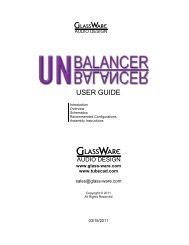Create successful ePaper yourself
Turn your PDF publications into a flip-book with our unique Google optimized e-Paper software.
GlassWare Audio Design<br />
Warning!<br />
This PCB contains a high-voltage power supply; thus, a real and lethal shock hazard<br />
exists. Once the power transformer is attached, be cautious at all times. In fact, always<br />
assume that the high voltage capacitors will have retained their charge even after the<br />
power supply has been disconnected or shut down. If you are not an experienced<br />
electrical practitioner, before applying the AC voltage have someone who is<br />
experienced review your work. There are too few tube-loving solder slingers left; we<br />
cannot afford to lose any more.<br />
Overview<br />
Thank you for your purchase of the GlassWare <strong>12B4</strong> <strong>CCDA</strong> stereo PCB. This FR-4<br />
PCB is extra thick, 0.094 inches (inserting and pulling tubes from their sockets won’t<br />
bend or break this board), double-sided, with plated-through heavy 2oz copper traces.<br />
In addition, the PCB is lovingly and expensively made in the USA. The board is 7 by<br />
6 inches, with five mounting holes, which helps to prevent excessive PCB bending<br />
while inserting and pulling tubes from their sockets.<br />
Each PCB holds two <strong>12B4</strong> <strong>CCDA</strong> (constant-current-draw amplifier) line-stage<br />
amplifiers (four <strong>12B4</strong>s); thus, one board is all that is needed for stereo unbalanced us).<br />
By including the necessary components for the heater and high voltage B+ power<br />
supplies on the PCB, the <strong>12B4</strong> <strong>CCDA</strong> board makes building a standard-setting line<br />
stage amplifier a breeze.<br />
PCB Features<br />
B+ and Heater Power Supplies On the <strong>12B4</strong> <strong>CCDA</strong> board, two power supplies<br />
reside, one for the high-voltage B+ for the tubes and a low-voltage power supply for<br />
the heaters. The high-voltage power supply uses an RC filter to smooth away ripple,<br />
while the low-voltage power supply uses a voltage regulator to provide a stable and<br />
noise-free voltage output. The heater regulator is adjustable and can be set to 6V or<br />
12V. The power supplies require an external power transformer(s) with two secondary<br />
windings (120Vac to 260Vac and 12Vac to 12.6Vac).<br />
Redundant Solder Pads This board holds two sets of differently-spaced solder pads<br />
for each critical resistor, so that radial and axial resistors can easily be used (radial<br />
bulk-foil resistors and axial film resistors, for example).<br />
Dual Output Coupling Capacitors Select between two coupling capacitors at the<br />
output. In addition, most capacitor locations find many redundant solder pads, so<br />
wildly differing-sized coupling capacitors can be placed neatly on the board, without<br />
excessively bending their leads.<br />
Power-Supply-Decoupling Capacitors The <strong>12B4</strong> <strong>CCDA</strong> PCB provides space for two<br />
sets of capacitors to decouple both <strong>12B4</strong> <strong>CCDA</strong> gain stages from the B+ connection<br />
and each other. This arrangement allows a large-valued electrolytic capacitor and<br />
small-valued film capacitor to be used in parallel, while a series voltage-dropping<br />
resistor completes the RC filter. (As an option, in place of the R17 series resistor, an<br />
off-board choke can be used for each channel.)

















